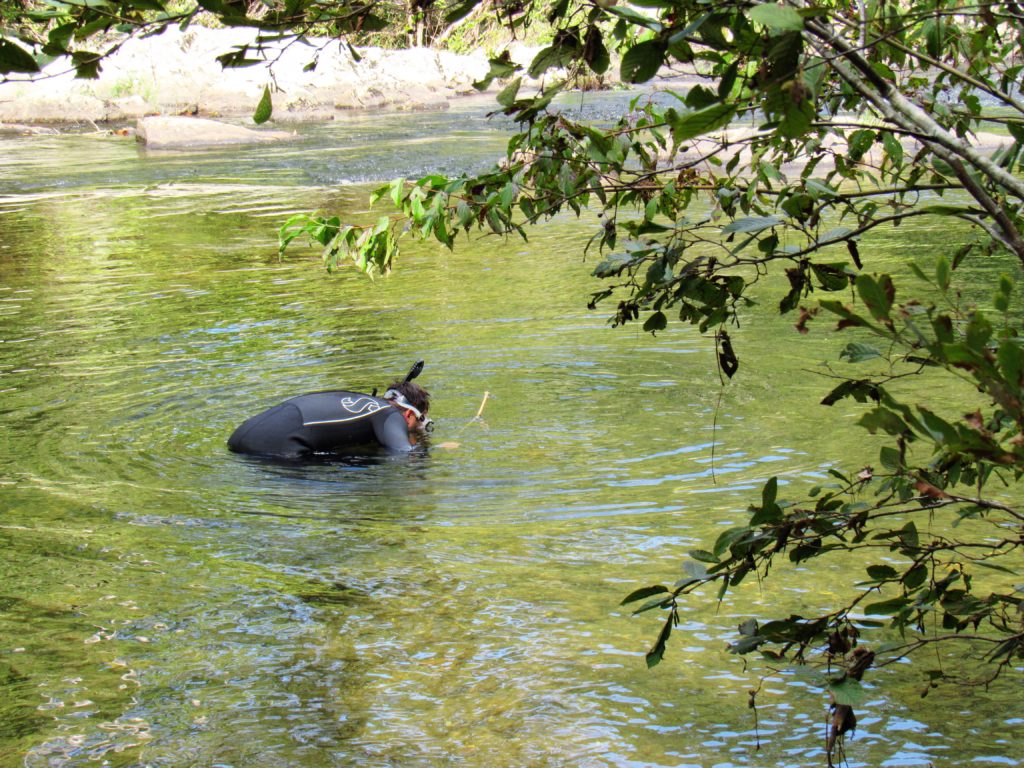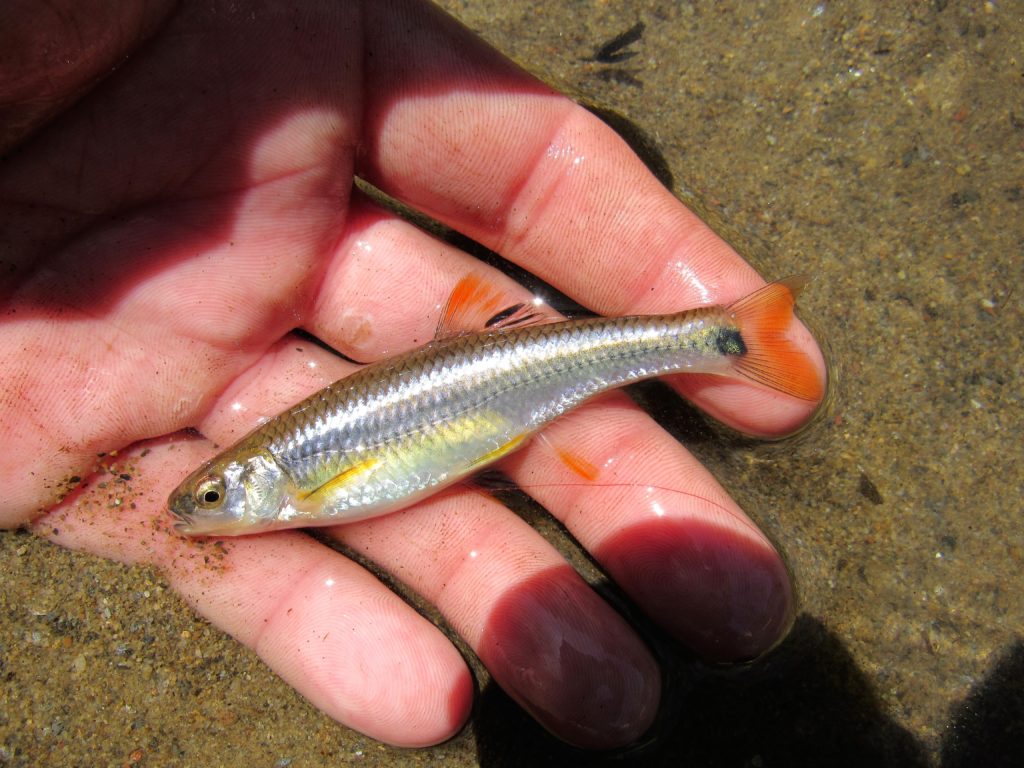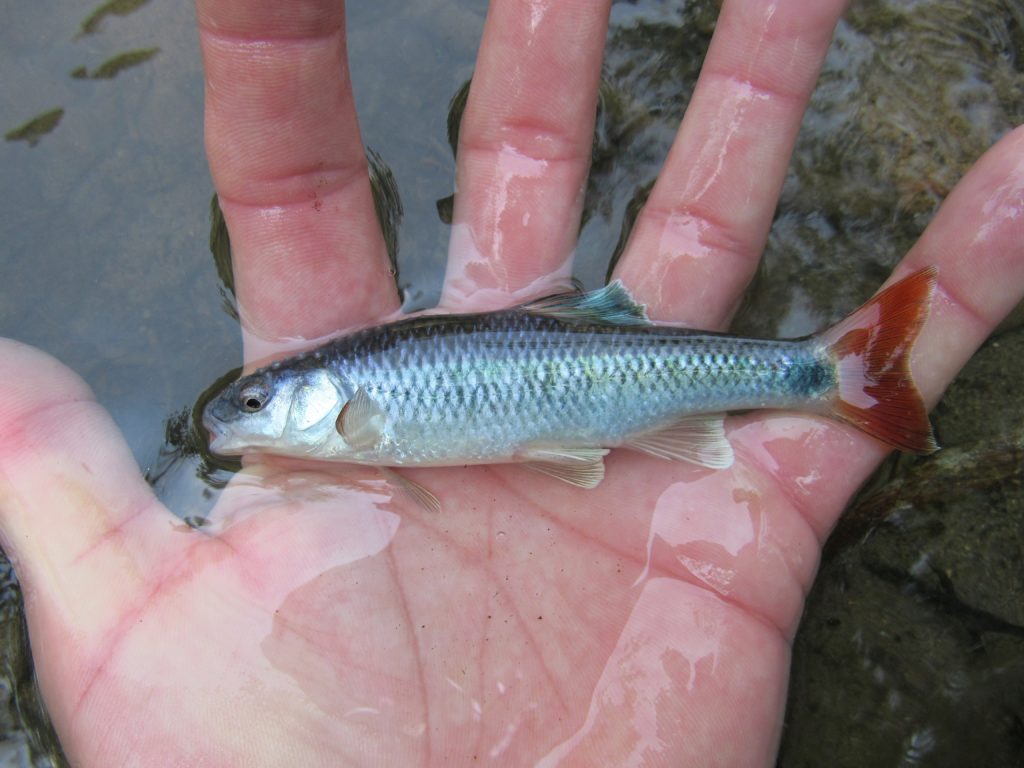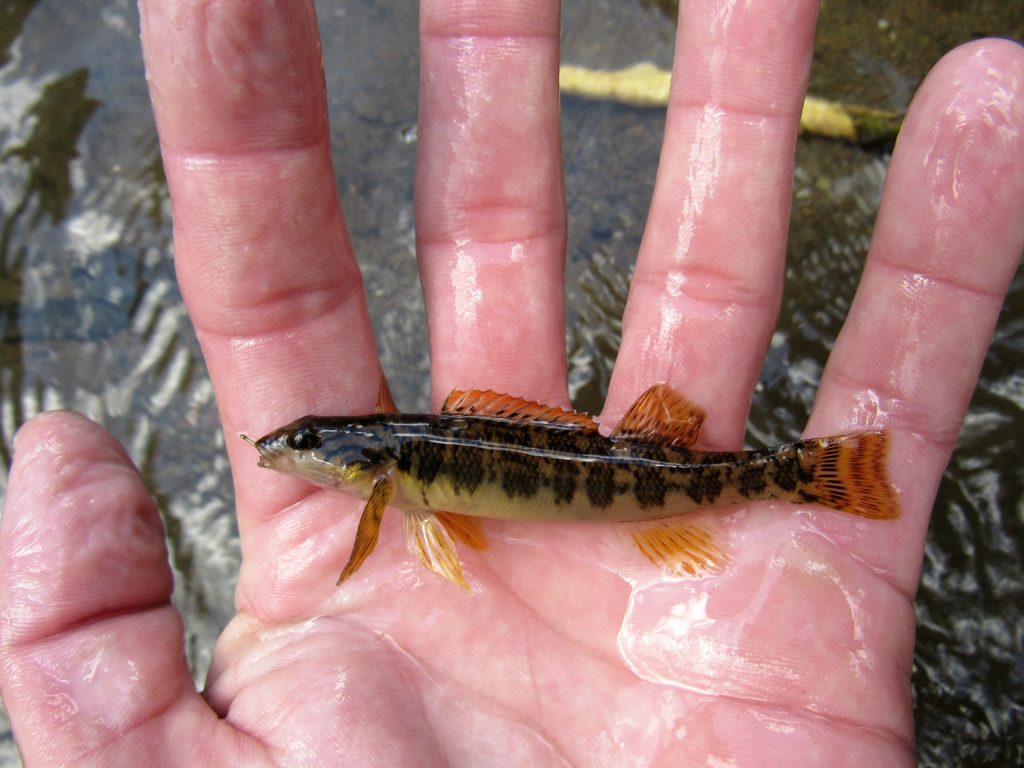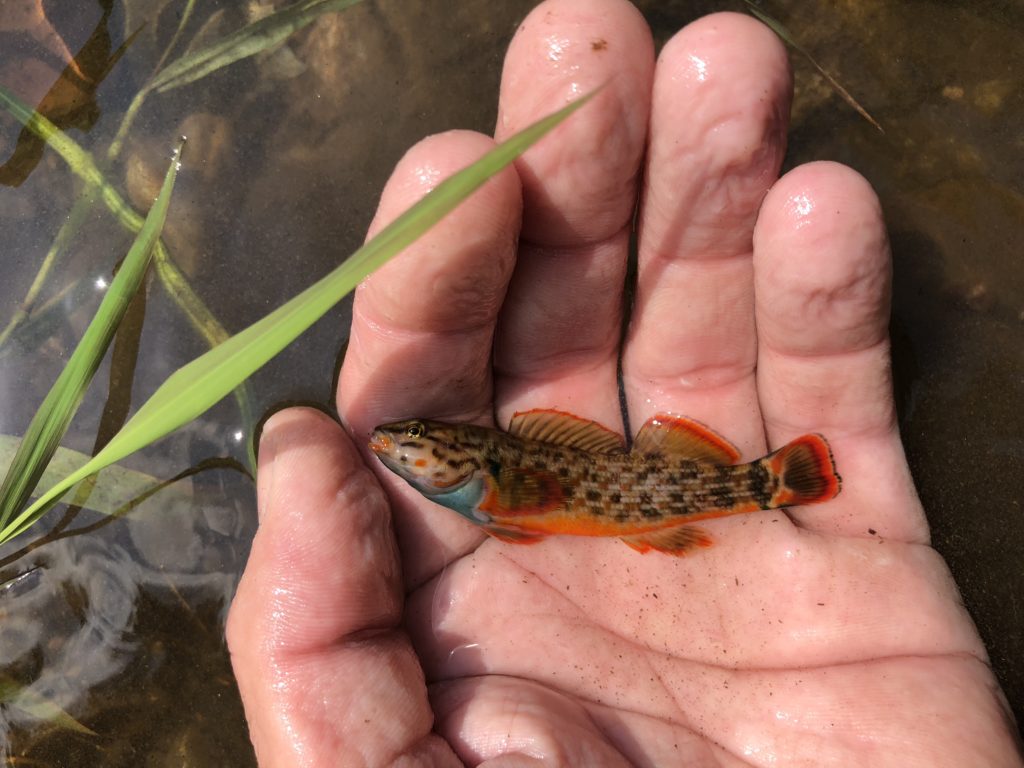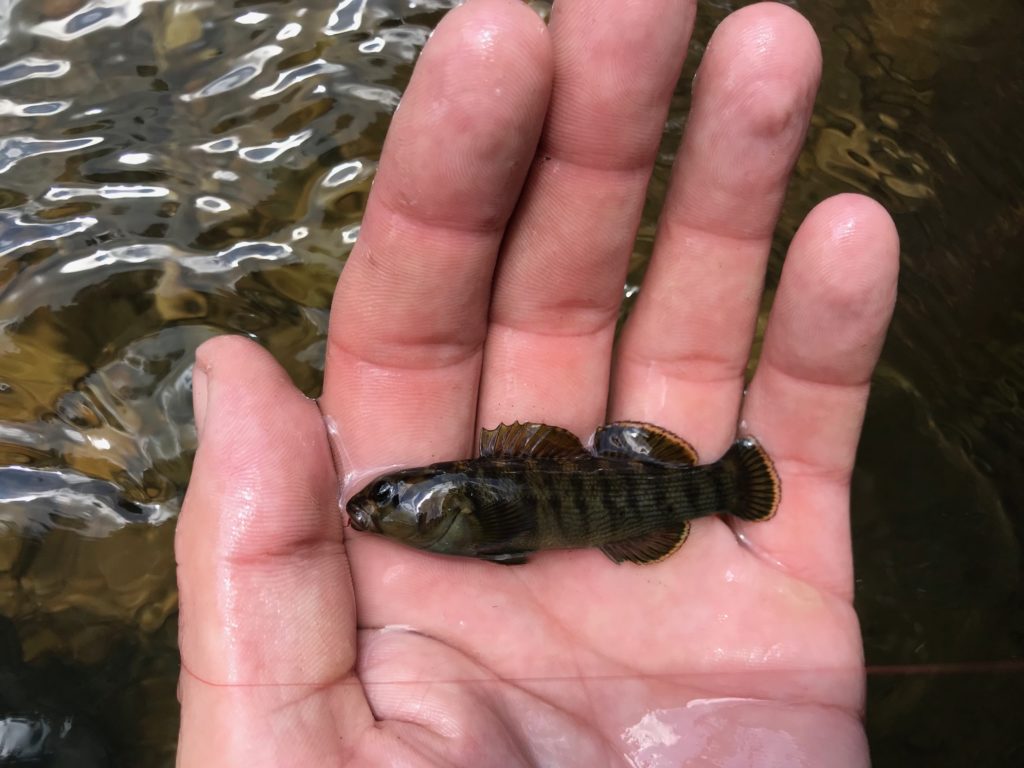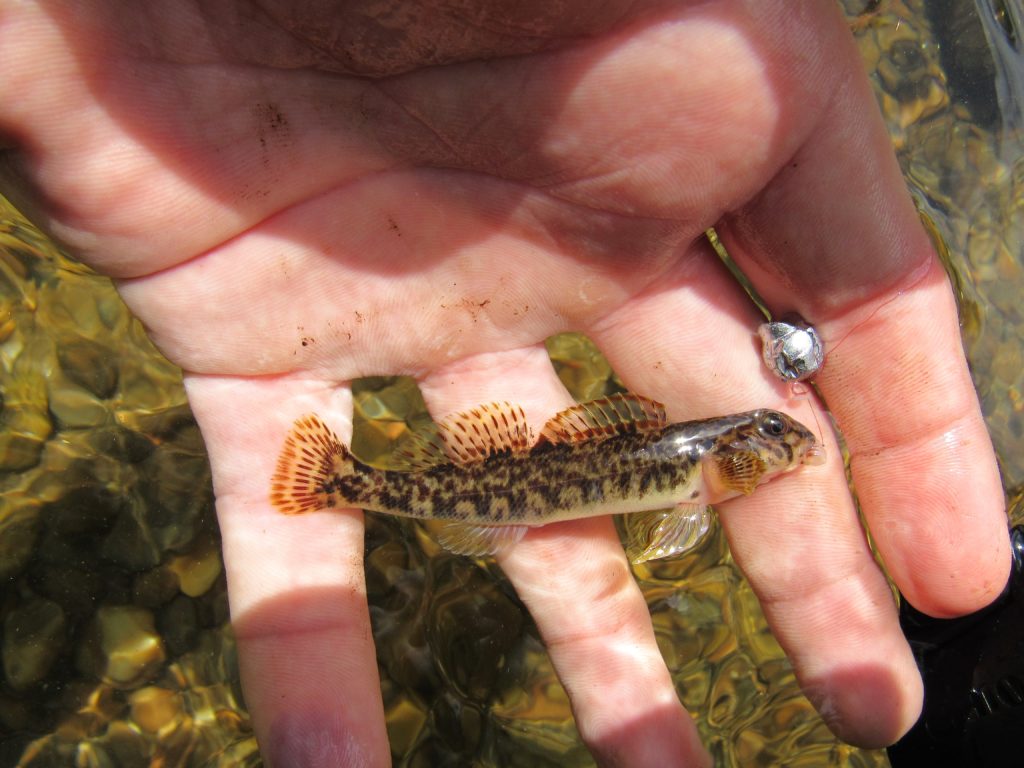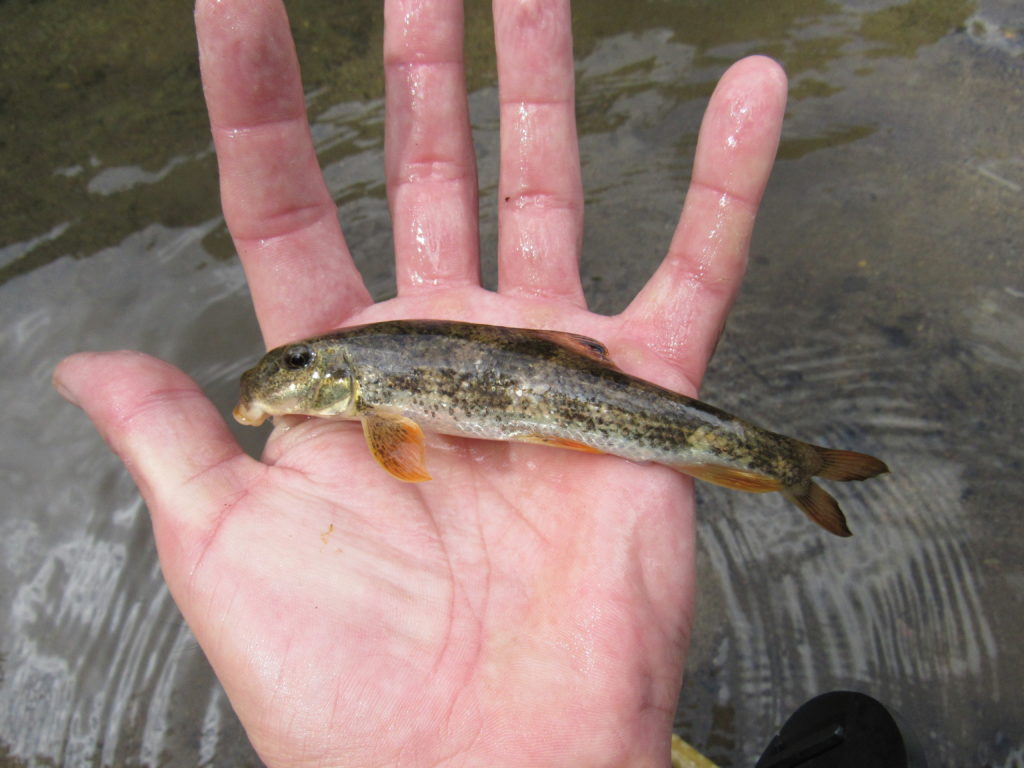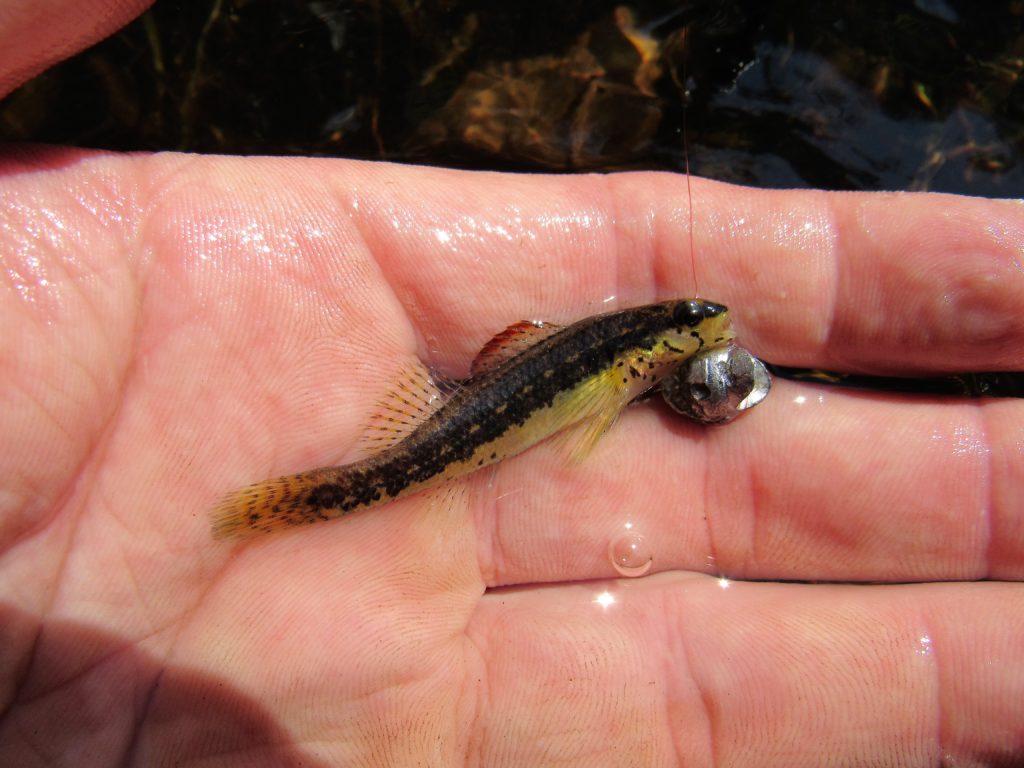By Tim Aldridge
It was a beautiful afternoon day on the Conasauga River in Tennessee when the idea struck me. My good friend Casper Cox was snorkeling up and down a riffle in the river, searching for Darters. I watched as the fish followed closely behind, no longer afraid, more interested, feeding from the silt kicked up as Casper swam along. Why not fish for them underwater? It was one of those moments where I knew I had come up with something amazing. The fish I had targeted on the Conasauga River were eluding me. Casper would swim along, as I curiously watched, coming to the surface to tell me which species he had just encountered. I walked along beside him, dropping my bait in the wake and feeding frenzy of fish that followed behind. I quickly caught Alabama and Tricolor Shiners, amazing breeding males at that. I learned that the Darters would require me to go underwater, and this I would have to save for a later date when I had the appropriate equipment. Afterwards, when Casper had come to sit with me on the riverbank, we discussed my idea. He thought it was a great idea, one that would have to be tested, soon.
I decided to keep my fishing gear simple. I would use the same hooks and weights as I used for microfishing, but I would need a shorter rod. I determined early on that I would be holding the fishing rod underwater while I fished, but not that far under. With this in mind, I simply fashioned a homemade fishing rod out of a backyard stick. I kept the stick short, around twelve inches, this would give me a good length to deal with underwater. My hooks, the hooks I use most of the time microfishing, are Owner “Smallest” Tanago hooks, size 30-and they come pre-snelled with about ten inches of line. By simply tying the loose end of the pre-snelled hook to the tip of the stick, I had my snorkelfishing rod! Since I would be snorkelfishing in swift current most of the time, I decided on a size 5 split shot, placed about an inch above the hook. Now my focus went to snorkeling gear. I shopped online and chose a suitable wetsuit at a decent price, a mask, snorkel and boots and was ready to go. I then lined up what I would say was a “revenge tour” of the Conasauga River.
I rose early for the almost four-hour drive from Waynesville, North Carolina to my favorite spot on the Conasauga River in Tennessee. The river, I knew, was my best shot at making snorkelfishing a success. It was the home of more than seventy native freshwater fish, and since I hadn’t caught that many of that number my last outing there and was looking forward to increasing my lifelist. I fitted myself with my new wetsuit, mask, snorkel and boots, tipped my size 30 hook with a tiny bit of red worm and headed into the water. My main targets were Darters, and the Conasauga was full of them. I placed my head underwater and found myself in a new world. I could see fish that I couldn’t see standing just inches from me, but underwater, the detail and plethora of activity amazed me. I was instantly hooked. I almost forgot the reason I was there, and that was to fish. I inched along, moving downstream with the water, grabbing hold of rocks if I needed to stop and fish. The Shiners quickly became a hassle, and would quickly hook themselves if you didn’t keep your eye on your bait. I caught, unintentionally… Alabama, Tricolor, and Coosa Shiners for the first twenty minutes, until I decided it was best to keep the bait and hook and weight in one hand while moving along, out of reach. After I learned this technique, I began to find the Darters. I focused on a medium size Bronze Darter that was perched near a big rock. I inched up slowly, making no sudden movements, getting closer with my bait. I extended my homemade stick rod towards the fish, who at this point was watching me intently. I was able to get the bit of bait near the mouth of the Darter, and to my surprise he bit! I set the hook quickly but not too stiffly, and brought the Darter out of the water and towards shore. I took and few deep breaths, and snapped some photos before releasing the fish. I was feeling ecstatic for catching the Darter, but I also wanted to get back in the water and catch more!
My favorite river near my home in Waynesville was my next location to try snorkelfishing. The Pigeon River was clear, cool, and home to Tangerine, Redline, Greenfin, Banded and Tuckasegee Darters. I had microfished the location several times, and was able to catch many Tangerine Darters above water, but the other Darters species were either too deep to see and sightfish, or impossible to see and in the riffles. Snorkelfishing would be necessary to catch these species of Darter. I first focused on the rocky riffle opposite of the hole where the Tangerine Darters would stay around. I almost immediately saw Redline, Banded and Greenfin Darters, though none of suitable size to catch, even with my tiny size 30 hooks. I moved along on my knees in the riffle, slowly, checking every rock, every crevice, every place a Darter would hide. After a few minutes I saw a nice large male Redline Darter, sitting on the river bottom in plain sight. I slowly dragged my bait across the bottom, inching it closer to the fish. The fish didn’t wait however, and came to me, inhaling the bait in one swift movement. I set the hook and immediately brought the Darter out of the water. It was such a beautiful fish, and I may have screamed a shout of joy that onlookers heard clearly.
After several weeks of refining my snorkelfishing techniques, I began to catch Darters and other microfish with ease. I caught six male Gilt Darters in one short afternoon snorkelfishing session in another river close to my home one day. I spent the majority of my time snorkelfishing the Pigeon River however. The river was made for snorkeling, microfishing, and snorkelfishing. The flow is not too fast or too slow, and the river has a plethora of fish species. My next targets were the Greenfin Darter and the Tuckasegee Darter. After studying habitat for my target species, I set out for the Pigeon. The water was clear as it could be, and just cool enough to have to wear a wetsuit. I saw Tangerine Darters in droves, and they are almost too easy to catch sometimes. Keeping your bait away from them is a challenge. After avoiding the Tangerine Darters, I searched rock to rock and eventually came to a crevice between two large boulders in the faster current near the riffle. I set my bait in the crevice and waited, knowing that there could be a Darter or Sculpin there. I saw a flash of movement in the crevice and knew something had happened to my bait. I lifted the rod tip up and to my surprise, pulled up a handsome adult Greenfin Darter. It was a gorgeous fish, and I wanted to quickly get it back in the water, but I also took the time to take some photos. Later on that week, with the same method I used to catch the Greenfin Darter, I caught two handsome Tuckasegee Darters. My spot on the Pigeon River was a gold mine, and after I caught nearly every species in the section of river I was in, I decided to give the Pigeon a rest and move on to larger opportunities.
Once again, I turned my attention to the Conasauga River, my friend Casper Cox’s favorite section of river. It was also becoming one of my favorites as well, but there were some troublesome species in the river that I had failed to catch on several occasions. One of those, which I had saw plenty of while snorkelfishing, was the Alabama Hog Sucker. The last time I was at the river, a fellow angler caught five Alabama Hog Suckers right in front of me. I was a little more than irritated, since it was a species I really wanted to catch on hook and line. I decided that this time, I would catch the fish, or stay until I did catch it. I walked in the shallow water of the Conasauga, and then went underwater and began my search for the Sucker. I had an idea where the fish would be, and I was right on the money in my search for its habitat. The Alabama Hog Suckers would travel behind the wake of debris that the other snorkelers would leave behind them, picking up small stones and debris and searching for food. I curiously approached a medium sized one, being cautious not to spook the gentle fish. I dropped my bait down into the water, in an area where the Hogsucker would likely go. I watched the fish approach my bait, which was on the bottom right in front of him.
In a flash the fish took my bait, and I brought my Alabama Hog Sucker out of the water. The feeling of catching a fish underwater is almost indescribable. When you snorkelfish, you become part of the fish’s habitat, becoming a lot closer to the species that you desire. I became excited to see that my little idea came to fruition and actually worked! A few hours after catching the Alabama Hog, I focused my attention once again to Darters. I was in luck this time, because Bronze Darters were active and out feeding, making them easy targets. I caught five Bronze Darters in less than an hour, including a large male beauty. I wrapped up my trip to the Conasauga after night fishing and catching a lifer Shadow Bass, however, I had still missed some Darters that continued to elude me. I would have to go back to Conasauga one more time, but for the time being, I focused on more local fish species that I wanted to catch.
After I moved from the North Carolina mountains and back to Waxhaw, in the Piedmont section of the state, I decided to try and catch the Pinewoods Darter (Etheostoma mariae). This was an elusive Darter with a very small range, and I knew that it hadn’t been caught on hook and line before. I was up to the challenge, and I headed to the tannic water, swampy habitat that the Pinewoods Darter lived in. After trying two known locations with no success, I headed to my final destination for the fish. To my surprise it was a nearly clearwater stream, and I could happily snorkelfish it. Before I decided to suit up, I walked up and down the stream, which was no more than a foot and a half deep, looking for Darters. I saw a couple Tessellated Darters, which I had caught plenty of in the past, and moved on, searching for any sign of the Pinewoods Darter. I had no luck, and suited up, hoping I could see the fish if I went underwater into their world. I picked the deepest hole past the riffle, and immediately saw two adult Pinewoods Darters. After a twenty-minute underwater chess match with the fish, I was able to convince one to bite, and I had the first and only Pinewoods Darter caught on hook and line. Although it was really no big deal, but it was a nice feeling to have.
It was astonishing to me that snorkelfishing actually worked, and it worked well, but the best part was that it was fun, snorkeling was really fun! Moving along, in the fish’s world, it is a different experience. The best part for me was seeing the fish in their natural habitat. Whether or not fishing is actually easier this way, well, to tell the truth, it’s not. Fishing underwater in the fish’s habitat is still challenging. Most of the juvenile species of fish can be tricked to bite consistently, almost annoyingly, but larger fish species sometimes know the game. Darters and some game fish are still difficult to catch, and often sneaking up on them from behind and presenting the bait slowly in front of them is the way to go. I learned so much snorkelfishing and gained so much valuable information that I was able to catch twenty different species of Darter in a six-month period in the Spring and Summer of 2018 My lifelist is now close to two hundred and fifty fish species, and thanks to snorkelfishing, it continues to grow. I have brought an interest in snorkelfishing to several of my friends and family, and even have my nine-year-old step-daughter out doing it. It is thoroughly enjoyable and relaxing, and if you are an angler, or just interested in native fish as a whole, snorkeling and snorkelfishing is the way to go. I still have a beef with the Conasauga River however, and until I catch the fish species I want there, I will continue to go back and try. I get better every time I go out and snorkelfish, and it becomes easier and easier to read rivers and fish habitat. I am happy it worked out.
Written by Tim Aldridge

